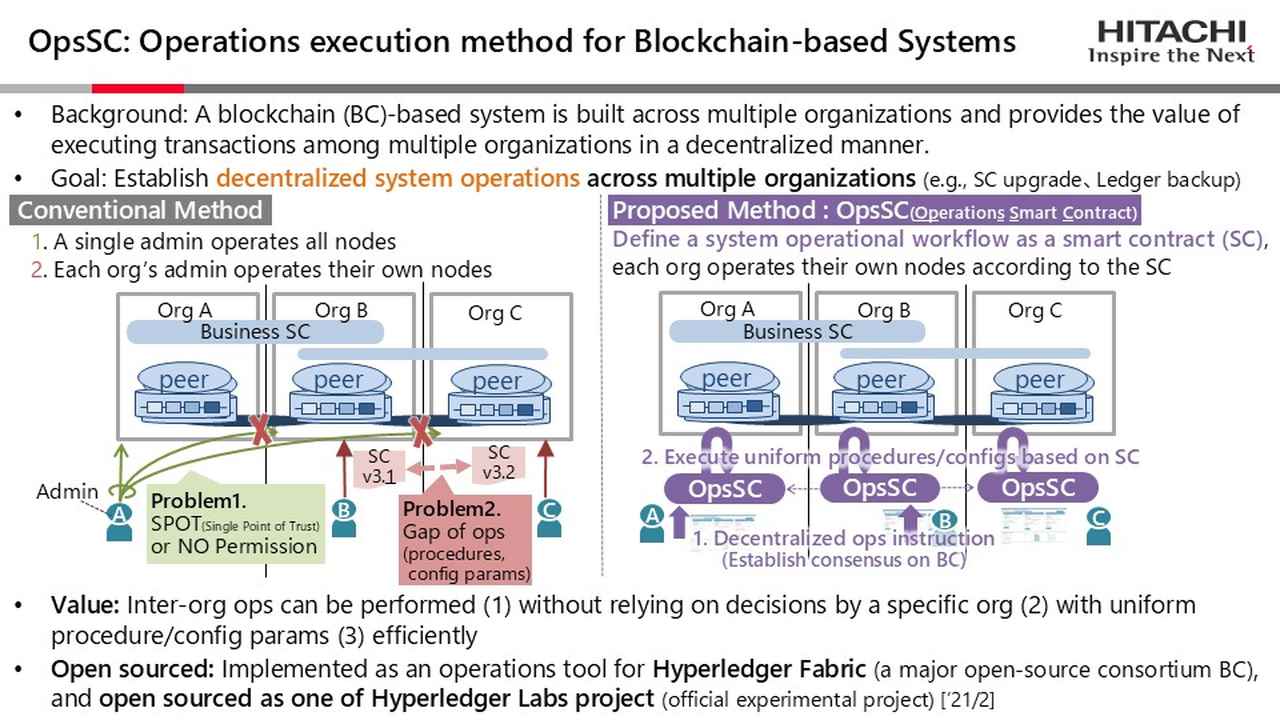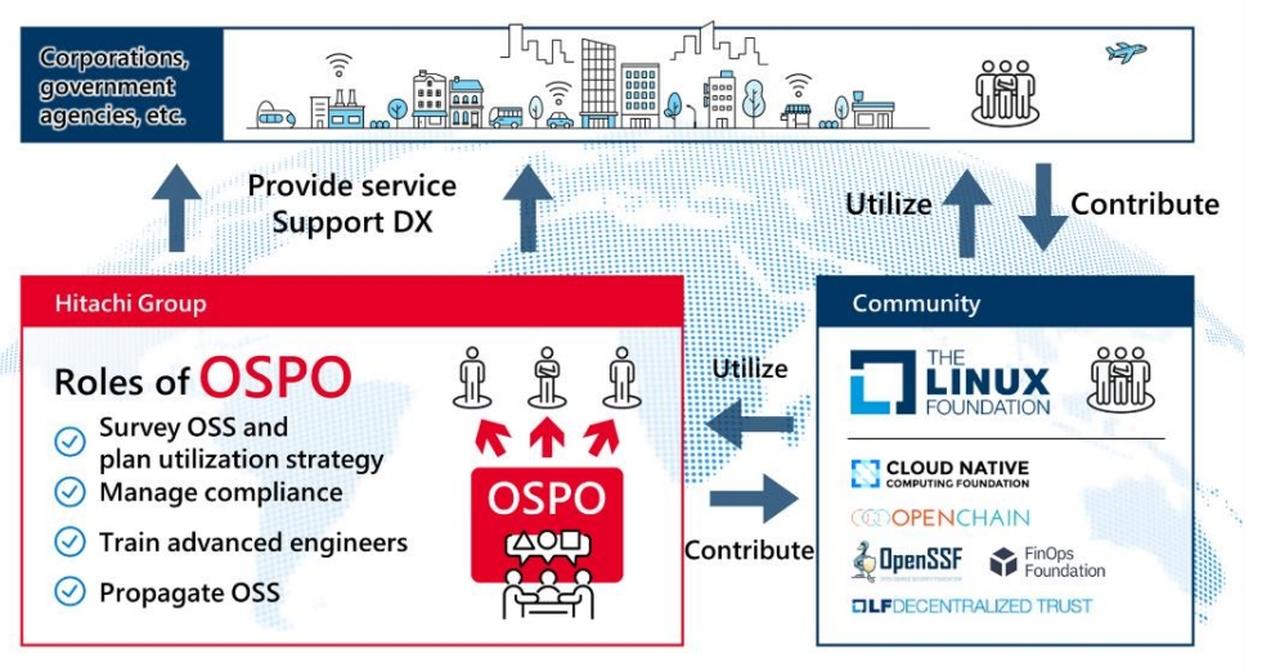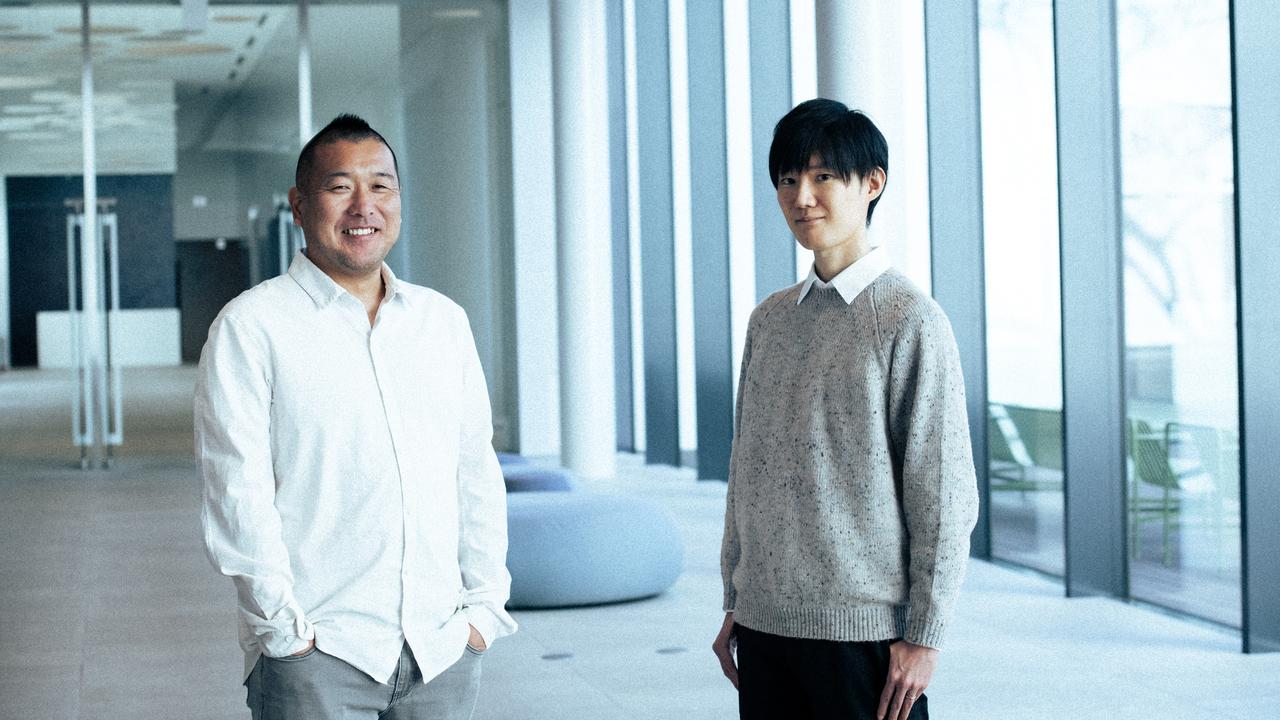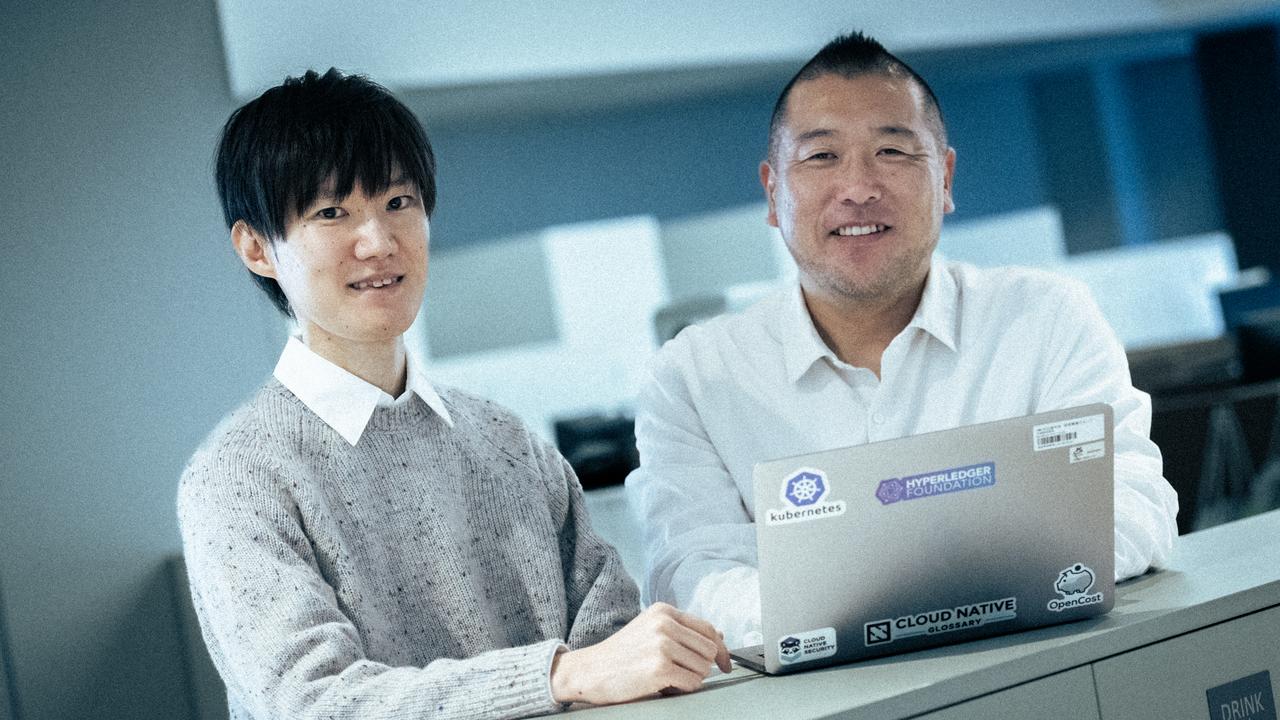An involvement with computers that goes back to my student days
Nishijima: My research in university was on the computational part of computational fluid dynamics (CFD), which covers topics such as Navier–Stokes equations. I studied ways of computing at high speed while reducing memory use. As I was also at the time working part-time in server administration and similar areas, my interest in computers was heightened further.

My interest in operating systems and kernels had me trying out UNIX and the like. That’s when I happened upon the book Understanding the Linux Kernel (Bovet and Cesati). A fascination of Linux is that it is used all over the world, and if a patch you contribute to the community gets adopted, it has a huge influence because the functionality you yourself made finds worldwide use. It so happened that the Japanese translation of this book was done by Hitachi researchers, and my encounter with it was one thing that led to my joining Hitachi. At Hitachi, I had the good fate of being assigned to the same workplace as those translators, where I became involved in Linux-related development. One of the first projects I worked on was implementing in Linux some functions used in mainframe computers for making them highly reliable, for the transition from a mainframe-based financial system to an open system.
Sato: Having decided relatively early on that I wanted to work in information and communication systems, I chose to study computer science in a technical college. I continued my studies in university and then went on to graduate school, all in the information science field. The time I entered graduate school was right when a new practical IT course had been introduced, through industry-academia-government collaboration. That course was taught not just by university faculty members but also by instructors from many different companies. They taught us about such topics as IT system development, which was extremely useful because we could learn specific knowledge from people on the front lines. Then one of these instructors came from Hitachi, who besides being smart and logical paid close attention to our needs as students. This got me thinking that in the future it would be nice if I could be this kind of person, and led to my considering a career at Hitachi.

My research upon joining the company included IT system operations such as improving the efficiency of work by administrators for industrial applications. The results of my research were implemented as an “Application Operation Navigation Service” solution for integrated operations and management of IT systems. When this development work was winding down, a blockchain R&D project was about to be launched and I was asked if I wanted to try something new, so next I became involved in blockchain research.
Cooperating in IT with OSS, and earning revenue in other areas
Nishijima: Besides the book on the Linux kernel having been translated by our Hitachi senior colleagues, for a long time there have been deep ties between The Linux Foundation and Hitachi. Back in 2000 when The Linux Foundation was started up, Hitachi along with companies like Fujitsu, NEC, and NTT were involved in its launch. Linux is released to the public as open source software (OSS). Hitachi used Linux in social infrastructure systems, which are a specialty of the company, and would do things like making the source code public.

The thinking, in other words, was to take the value in the IT area that was raised by OSS and apply it in areas such as social infrastructure and operational technology (OT). One way of earning revenue in these markets is to capture a larger share, such as going from 10 percent to 20 percent; but another way is to expand the markets themselves. Considering that the latter approach is one of working with other companies, who are competitors, to grow the market by advancing services to a higher level, there is value in cooperating in the OSS area. This can no doubt be called the true “front lines of open innovation.”
Hitachi, moreover, provides Lumada, solutions that create value from the customer’s data and speed up digital innovation. We believe OSS can contribute also as a means for accelerating the directionality of Lumada.
With the establishment of the CNCJ, the presence of Japan’s IT was maintained
Nishijima: In parallel with OSS use, Hitachi contributes to the activities of the nonprofit organization CNCF (Cloud Native Computing Foundation) . By backing container technology, this organization promotes the transition to cloud-native technology, that is, carrying out development directly in the cloud from the start, without making use of physical servers such as for on-premise development. In 2016, Google granted the CNCF the intellectual property rights to Kubernetes, OSS used for optimization of container operation, and the CNCF began its activities in earnest, with the cooperation of The Linux Foundation. Then in November 2023, the CNCJ (Cloud Native Community Japan: a neutral group bringing together the CNCF with Japanese companies and organizations to promote CNCF activities and the spread of cloud-native technologies in Japan) was started up as a Japanese community of the CNCF, and is carrying out activities together with companies including NEC, Fujitsu, Toyota, Preferred Networks, and Apple.

Sato: Today it is taken for granted that the world’s leading-edge systems are built making use of OSS. For Japan to maintain a strong presence in IT, it is important to energize the OSS community together with many of Japan’s leading companies. I think where Japan can contribute in particular is from the standpoint of the nation’s sensitivity about quality and stability, and its unique practices. I spent some time in North America, and felt a certain amount of inconvenience the way banking systems would stop working now and then, or smartphone apps could not be used on some days. This kind of thing would be a serious matter if it happened in Japan, with its strong demands for quality and stability.
Among the areas where Japanese companies are being looked to with great expectations is in offering LTS (Long-Term Support), which in the OSS scheme refers to specific software versions for which long and stable support will be provided. The kinds of activities Japan can carry out include conveying requests that are uniquely Japanese and providing support in the quality area. In the future, if Japan’s specifications with their focus on long-term stable operation are adopted, we should see things moving in the direction of higher OSS quality.
Nishijima: Since November 2023, I have been serving as CNCF ambassador, responsible for propagating cloud-native technology throughout the world. Around 270 people have been appointed as ambassadors worldwide, of which eight of us are in Japan. In my role as ambassador, I would like to arouse greater interest in cloud-native in Japan. Since there are people in Japan who are not proficient in English, my activities are centered around translating CNCF leading-edge documents into Japanese.
Contributing to OSS also in the Hyperledger Fabric project
Sato: Another specific area of OSS-related activity by Hitachi is the Hyperledger Fabric development project. This is a blockchain OSS framework aimed at enterprise users. I was assigned to this project in April 2024 in the leadership role of core maintainer, which marked a first among Japanese companies.
Let me explain the project in a bit more detail. Blockchain is technology for storing transaction records (ledgers) in multiple nodes distributed on a network and linked using cryptography, aimed at guaranteeing data identity and reliability. There are public blockchains open to anyone, like those used for Bitcoin and Ethereum, and consortium blockchains whose use is restricted to authorized organizations. Assumed uses of consortium blockchains include business process reform across organizations, and new value distribution such as environmental value transactions.
In the Hyperledger Foundation*1 under The Linux Foundation, technology development is being carried out mainly for consortium blockchains aimed at enterprise users. It so happens that Hitachi has been a Premier Member of the Hyperledger Foundation, one of its core members, since it was established in 2016; and among the many projects being undertaken by the Foundation, Hitachi has contributed especially to the development of Hyperledger Fabric. It is already being used in a wide range of fields, including finance and healthcare.
*1 Note that in September 2024, the Linux Foundation Decentralized Trust (LFDT) was formed as the umbrella organization that includes the Hyperledger Foundation. The LFDT is a new integrated organization promoting collaboration and innovation in the overall ecosystem in which blockchain, ledgers, identity, interoperability, cryptography, and related technologies are growing.

One of the difficulties with a consortium blockchain has been that if a chairperson or the like was put in charge of deciding governance, authority would in some cases become overcentralized. At the same time, the main interest and concern of the development community at the time tended to be concentrated on speeding up processing. This is why, after joining Hitachi, I drew on the results of my research on system operations to develop Operations Smart Contract (OpsSC), system operations technology capable of decentralized management of governance and operations. I then introduced an implementation for Hyperledger Fabric to the community and had it officially recognized as OSS. As I continued to propose improvements to Hyperledger Fabric based on this knowledge, I was appointed as core maintainer.
Strengthening of internal and outside collaboration with the establishment of OSPO declaring OSS use
Nishijima: Then in November 2024, Hitachi established the Open Source Program Office (OSPO) as an organization aimed at becoming a global leader in strategic use of OSS. While companies throughout the world are beginning to recognize the importance of taking strategic advantage of OSS, the OSPO is an organization officially declaring use of OSS as a corporation, which in Japan, companies like Toyota Motor and Sony have taken the lead in establishing. Globally, the GAFA companies and more than 100 others, such as Siemens and Goldman Sachs, have established such offices.
As we have been noting up to now, even before establishing the OSPO, Hitachi has been an active user of OSS; but it was up to each business division to decide its activities in this area, and there was no unified initiative in the company as a whole. Now that the OSPO has been established, I would like to make a strong appeal in the company to the effort we will be putting into OSS. At the same time as being the place to go for consulting on OSS use in Hitachi, this office will also be a liaison point with outside OSS-related organizations and communities such as The Linux Foundation.

Overview of the Hitachi Open Source Program Office
The Hitachi OSPO started out with 60 people, but is to be expanded in the future to around 100 members, including global members. They come not only from digital-related divisions, but people interested in contributing to the OSS community were chosen from a variety of divisions including infrastructure, intellectual property, human resources development and many more. Our hope is that through these activities, the standing of OSS community activities in the Hitachi Group will be elevated. With the specific roles of “surveying OSS and planning utilization strategy,” “managing compliance,” “training advanced engineers,” and “propagating OSS,” the office intends to contribute to DX acceleration by customers in a wide range of fields.

Sato: Many of the members retain their roles in business divisions, and are able to serve as liaison between the office and their respective divisions, as a framework has already been set up enabling sharing of issues and needs across different segments.
Nishijima: Now that an organization called the “Hitachi OSPO” has been explicitly established, many inquiries have come from inside the company and collaboration has become easier; but toward the greater use of OSS, we would like to make our presence more widely known, letting the global Hitachi Group know that we are here. I believe the OSPO efforts have the potential for greatly changing the corporate culture, including organizations and institutions. It may be a bit of an exaggeration, but I have the feeling that this may be an occasion for making both IT and OT sustainable over the next 100 years of Hitachi.
Sato: There has been quite a response also from outside the company. When taking part in meetups with OSS people from many different companies, they would say things like, “So Hitachi has started up an OSPO,” and that would lead to talking with each other about our respective initiatives. In taking part in the open source community as a corporation, we are still trying to find our way about many aspects; but I hope the OSPO will lead to our deepening communication with numerous companies, learning the best parts from each other, and helping to refine IT/OT/DX throughout Japan.
Nishijima: Hitachi is involved in infrastructure projects in many fields, and of course IT is a specialty. I think even looking worldwide, there are very few corporations with their hands in both areas. This puts Hitachi in a unique position of being able both to bring to the OSS community the thinking demanded in IT/OT/DX, and to bring to IT/OT/DX the technologies of the OSS community.

Nao NISHIJIMA
Chief Researcher
Services Computing Research Department
Digital Infrastructure Innovation Center
Digital Innovation R&D
Research & Development Group, Hitachi, Ltd.
A book that was the occasion both for joining Hitachi and for becoming part of the OSS community
I would like to introduce a book I read as a student (in translation by Yumiko Sugita and others, with supervision by Hirokazu Takahashi), Understanding the Linux Kernel (by Daniel P. Bovet and Marco Cesati, published by O'Reilly). I picked it up thinking it would be useful in the future if I could grasp the Linux kernel, the heart of a computer. The first time I read it, though, it went right over my head. All the translators of this book, however, were Hitachi people; and after I joined Hitachi, if there was something I didn’t understand I could go and ask them. From there things grew, and I came to be part of the OSS community. It was truly a book that changed my life.

Tatsuya SATO
Chief Researcher
Services Computing Research Department
Digital Infrastructure Innovation Center
Digital Innovation R&D
Research & Development Group, Hitachi, Ltd.
An encounter as a technical college student that influenced my career path and research themes
A book I encountered in technical college is Introduction to Design Patterns Learning in Java Language by Hiroshi Yuki (SoftBank Creative), aimed at programmers who want to learn about design patterns or those who want to understand the essence of an object-oriented approach. Coming at a time when programming was still unfamiliar territory, I found it revolutionary that you could make a GUI program with Java for free. Learning from this book about software engineering (object-oriented development, design patterns, UML [Unified Modeling Language], and more), my world expanded. The things I wanted to make could be made with software. This book was the starting point, arousing my interest in software engineering and development, and influencing my decision to go on to graduate school, as well as my choice of employment.











